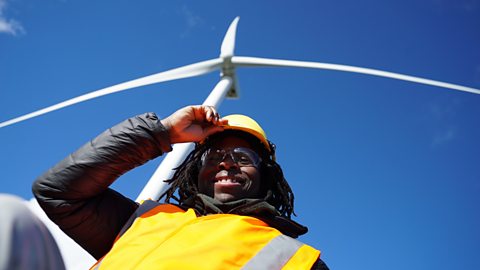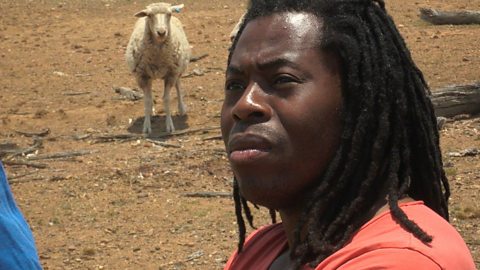Ade Adepitan travels to Tasmania to find out about the work being done to protect the carbon-capturing underwater kelp forests.
ADE: Hi, IÔÇÖm Ade and IÔÇÖm here in Tasmania which is a beautiful, rugged island off the south coast of Australia and IÔÇÖm here to find out about an amazing project to help suck up carbon from the atmosphere
The waters around here have something in them that could help save our planet.
Hi guys.
CRAIG JOHNSON: Welcome.
ADE: Hey, Craig. You alright?
CRAIG JOHNSON: Yeah, good to see you.
ADE: Ah, nice to meet you.
CRAIG JOHNSON: Cool.
ADE: Professor Craig Johnson and his team plant forests - not on land but underwater. These waters are home to one of the plant worldÔÇÖs most incredible species: giant kelp. As it grows, like all plants, it sucks up carbon dioxide and stores it away. But giant kelp is one of the fastest-growing plants on the planet and can capture carbon more quickly than a rainforest.
CRAIG JOHNSON: It can actually grow up around 40, 50 centimetres a day. The uptake of carbon is just fantastic.
ADE: But the giant kelp around here is struggling. Almost all of it has died because of warmer sea temperatures. But despite the warmer waters, some of the giant kelp is surviving. Craig and his team are trying to plant more of this resilient kelp that can survive in the warmer temperatures.
CRAIG JOHNSON: This brown scuzzy stuff on the outside of that string that's wrapped around that plastic pipe. Yeah. They are tiny little kelps.
ADE: That's little kelps?
CRAIG JOHNSON: That is little kelp, and we'll take that string down to the bottom.
ADE: OK, shall we get ready to do this then?
CRAIG JOHNSON: Yeah. Let's go. Let's go and get cold and put some kelp down.
ADE: ThereÔÇÖs no looking back now.
The hope is that CraigÔÇÖs tiny saplings will take root and spread in todayÔÇÖs warmer waters. But the kelp faces another threat beyond the water temperatures: sea urchins. The warmer waters have brought a new invasive species to Tasmania and there are now tens of millions of them here. They eat kelp and can create underwater deserts, pretty much empty of life. So to give the giant kelp a fighting chance, the urchins have to go.
CRAIG JOHNSON: LetÔÇÖs dump ÔÇÿem out. So this guy here with the great big spines is the invasive species. I'm gonna put a glove on because it does make it a little easier to handle these guys.
ADE: Yeah, I mean they are pretty spiky. Oh, my days! And itÔÇÖs moving!
CRAIG JOHNSON: This one, itÔÇÖs upside down so weÔÇÖre looking at the underneath of the urchin and you can see the very tip here with those five teeth coming together there.
ADE: Those are the teeth, those white things?
CRAIG JOHNSON: Those white things there. If you feel those teeth, you can feel
ADE: Will I be alright? [CRAIG JOHNSON LUNGES TOWARDS ADE WITH AN URCHIN] You idiot.
CRAIG JOHNSON: You'll feel how hard they are. They're incredibly hard. they can just absolutely chomp through things.
ADE: To stop the urchins from eating kelp, Craig is keen to encourage people to eat the urchins.
I'm not going to eat that.
CRAIG JOHNSON: Yes, you are. There are many reasons why youÔÇÖre going to remember me, Ade. And this is, this is a prime one. Just pop it in, chew it.
ADE: All of it?
CRAIG JOHNSON: All of it.
ADE: Ah! Thats quite salty. Thats quiteits got a weird texture Oh, my days!
Even if urchin gonads end up in every supermarket, it wonÔÇÖt be enough on its own to save our planet, but small, simple fixes like this can all help to fight climate change.
Video summary
Ade Adepitan travels to Tasmania to find out about the work being done to protect the carbon-capturing underwater kelp forests.
Giant kelp is one of the fastest-growing plants on the planet, it can capture carbon more quickly than a rainforest. However, the giant kelp in Tasmania is struggling. Almost all of it has died because of warmer sea temperatures and a new invasive species of sea urchins. They eat kelp and can create underwater deserts.
This clip is from the ┤¾¤¾┤½├¢ Two series Climate change: Ade on the frontline.
Teacher Notes
Before watching the film
This film can build on studentsÔÇÖ understanding of climate change impacts and the interdependence of natural systems. It is helpful if students have some understanding of global circulation patterns and realise that some parts of the world are affected more than others as a result of climate change caused by human activity.
You may wish to recap what students know and think about climate change, carbon dioxide, and other greenhouse gases arising from human activity. It could also be useful to know what students know about the ability of natural systems such as forests, to capture carbon.
Equally, the film can provide an enquiry point for developing early understanding about climate change and its related impacts on people and environments.
During the film
You may wish to stop at relevant points during this short film to pose questions and check understanding or wait until the end. You might want to ask students, for example, how they felt when they were told that giant kelp can grow up to 40-50 centimetres in a day and can capture carbon more quickly than a rainforest.
You might also want to ask:
- What other benefits might giant kelp forests like this one offer apart from helping to combat climate change? E.g. providing sanctuary and shelter for other creatures, supporting eco-tourism and biodiversity.
- Why is just a small percentage of the giant kelp managing to survive the increased temperatures?
- You could use this as an opportunity to discuss how one of the major problems with the rate of climate change that we are currently facing is that many species cannot adapt sufficiently quickly. Processes such as natural selection take time which is why intervention strategies such as actively replanting kelp can be effective.
- Why is this area now plagued with sea urchins?
- Can you give an example of local mitigation (e.g. afforestation, planting kelp) and adaptation (e.g. eating sea urchins)?
- You might discuss how mitigation and adaptation are interlinked and how these problems require local and global solutions working together.
- You could also ask students if they would be willing to try eating sea urchins and if they think incorporating them into the human diet is a useful and sustainable approach to avoid these migrated creatures stripping kelp forests bare and creating so called ÔÇÿurchin barrensÔÇÖ.
Following on from the film
Establish locational context.Use maps and globes to establish where the island of Tasmania is and note the latitude and ocean context; locate and name the Tasman Sea.
It could be useful to create a glossary of important definitions and terminologies such as ÔÇÿurchin barrensÔÇÖ and use this to support a map and / or diagram indicating some of the connected problems caused by temperature rise in the seas around Tasmania.
You could ask students to research where else in the world naturally occurring forests of giant kelp might be found and map these, noting climate zones and biomes. For example, in some kelp forests off the coast of California, populations of sea otters thrive and eat sea urchins. Students might do a comparison of the stresses facing these kelp forests at different locations.
Although there is some disagreement about the exact rate of temperature increase here, it appears that temperature rise is happening more quickly in Tasmania than other parts of the world: it is an ÔÇÿocean hotspotÔÇÖ. Older students could research and present climate data alongside a timeline of kelp decline, explaining the causes and impacts of sudden temperature rise on these marine eco-systems.
You may also wish at this point to reinforce the terms ÔÇÿmitigationÔÇÖ and ÔÇÿadaptationÔÇÖ and ask students to identify mitigation strategies we can use here to combat climate change impacts elsewhere (e.g. ways we can reduce our own carbon footprint and increase carbon capture by planting more trees).
This short film is suitable for teaching KS3 and KS4 students. It can be used alongside the other Ade Adepitan films about climate change or watched on its own. All the films build on studentsÔÇÖ understanding of climate change issues and enable them to make global connections.
This film supports the KS3 geography curriculum by investigating our changing climate and how human and physical processes interact to influence and change landscapes and environments.
At KS4, the film supports understanding about the impacts of rapid climate change on environments and peopleÔÇÖs lives. The film might also be used for example to investigate how strategies, such as afforestation, are used to respond to natural hazards and help manage the impacts of climate change (AQA).
This clip could be used to support the delivery of geography to KS3 and KS4 students. Specifically, this topic appears in OCR, Edexcel, AQA, WJEC KS4/GCSE in England and Wales, CCEA GCSE in Northern Ireland and SQA National 4/5 in Scotland.
Sea level rises in the Solomon Islands. video
Ade Adepitan travels to the Solomon Islands to see the dramatic effect rising sea levels are having on local communities.

Renewable energy in Tasmania. video
Ade Adepitan visits a wind farm in Tasmania that will help the island to reach a major milestone: producing all of its electricity from renewable sources.

Drought in Queensland, Australia. video
Ade Adepitan visits Queensland, where drought has had a devastating effect on the landscape.

Reducing food waste in Sydney, Australia. video
Ade Adepitan visits Sydney to learn about an organisation that redistributes food that would otherwise be wasted.
